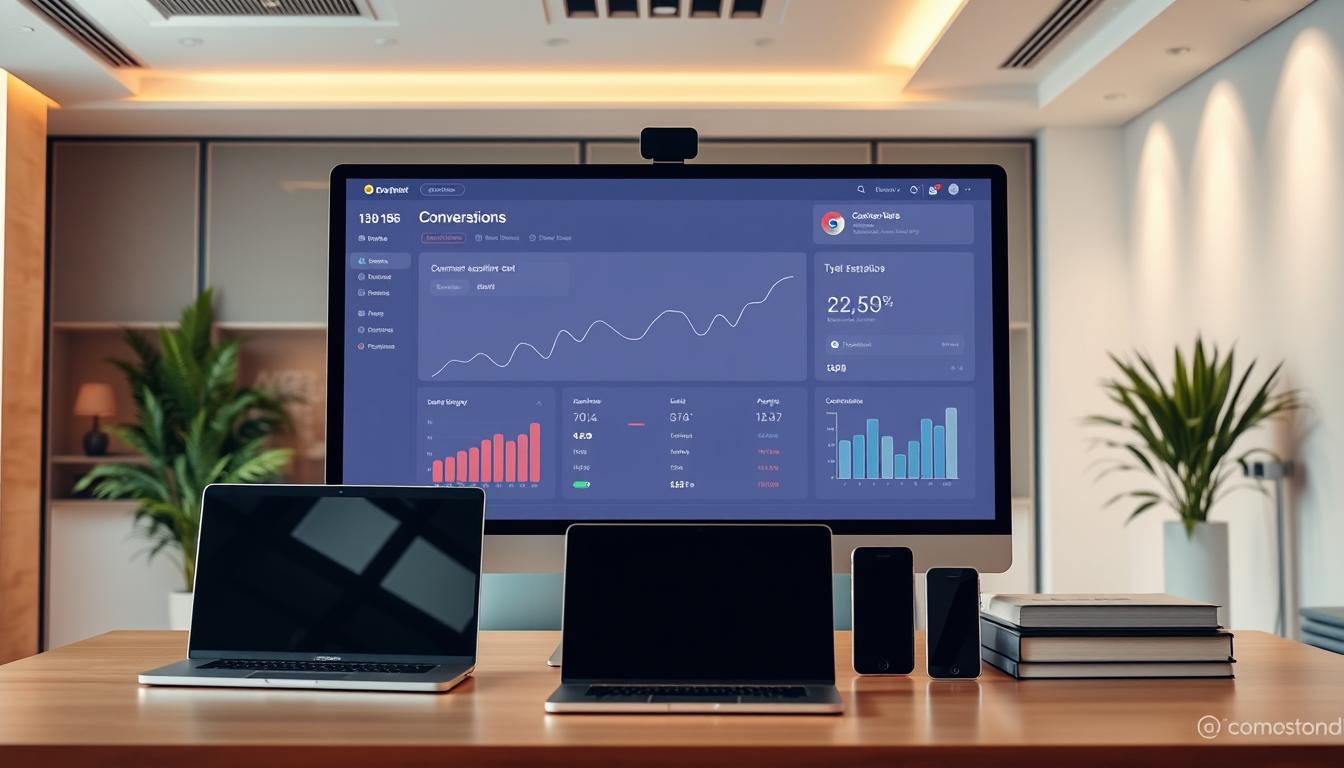Are you struggling to turn visitors into customers? Improving your website's conversion rate can be a game-changer for your business.
To boost your conversion rates, it's key to first understand your current performance. Analyzing your analytics and user behavior gives you insights into what's working and what's not on your site.
In the next 30 days, we'll show you how to analyze your current performance. We'll help you find areas to improve and make changes to boost your website's conversion rate optimization.
Key Takeaways
- Understand the importance of conversion rate optimization.
- Learn how to analyze your website's current performance.
- Discover ways to improve user experience and conversion rates.
- Get a 30-day plan to enhance your website's conversions.
- Implement data-driven decisions to boost conversions.
Understanding Your Current Conversion Rate Performance
It's key to check how well your website is converting visitors. To do this, you need to look at your website analytics and see how users behave.
Analyzing Your Website Analytics and User Behavior
Knowing how users interact with your site is important for making it better. You should track important metrics and use tools like heatmaps and session recordings. These tools give you insights into how users act on your site.
Key Metrics to Track
When checking your website's performance, focus on bounce rate, average session duration, and conversion rate. These metrics tell you how well users are engaging with your site.
Using Heatmaps and Session Recordings
Heatmaps and session recordings give you a visual look at user behavior. They show where users click and how far they scroll. This helps you see what needs improvement on your site.
Identifying Key Conversion Bottlenecks
Conversion bottlenecks are parts of your site where users stop or don't convert. Finding these bottlenecks is key to boosting your conversion rate.
Exit Pages Analysis
Looking at exit pages helps you see where users leave your site. This info can help you make those pages better and keep users from leaving.
Form Abandonment Issues
Form abandonment is a big problem that can hurt your conversion rate. By analyzing form abandonment, you can find and fix issues that make users leave.
| Metric | Description | Impact on Conversion Rate |
|---|---|---|
| Bounce Rate | Percentage of visitors who leave without taking action | High bounce rates can indicate poor engagement |
| Average Session Duration | Average time users spend on your site | Longer sessions often indicate higher engagement |
| Conversion Rate | Percentage of visitors who complete a desired action | Directly measures the effectiveness of your site in achieving goals |
Proven Conversion Rate Optimization Strategies for Immediate Results

To boost your website's conversion rate, using proven CRO strategies is key. These methods can lead to quick results and unlock your online full power.
Clarifying Your Value Proposition
A clear value proposition grabs the attention of possible customers. It shows the special benefits of your product or service.
Crafting Compelling USPs
A strong Unique Selling Proposition (USP) sets your business apart. It clearly shows why your product or service is the top choice.
Communicating Benefits vs. Features
When you market your product or service, focus on benefits, not just features. Benefits tell how your product or service solves a problem or makes life better.
Refining Messaging and Calls to Action
Good messaging and clear calls to action (CTAs) are key for guiding visitors. Your message should connect with your audience and push them to act.
Creating Urgency and Scarcity
Creating a sense of urgency or scarcity can drive visitors to act. Offers that are only available for a short time or limited stock can encourage quick action.
Optimizing Button Text and Placement
The text and where you place your CTAs greatly affect conversion rates. Use action words on your buttons and put them where they're easy to see.
Simplifying Landing Page Design
A well-designed landing page is essential for converting visitors. Make your landing page simple to improve user experience and boost conversions.
Reducing Visual Clutter
Less visual clutter on your landing page helps focus visitors on your main message and CTA. Remove anything that takes away from your main goal.
Improving Page Load Speed
Page load speed is vital for user experience and conversion rates. Optimize images, use browser caching, and cut down code to speed up your page.
Implementing A/B Testing for Data-Driven Improvements
A/B testing is key to boosting your website's conversion rates. It helps you understand what your users like best. By testing different parts of your site, you can make smart choices that improve your conversion rate improvement.
Setting Up Effective A/B Tests
Getting the most out of A/B testing starts with setting up right. You need to pick the best testing tools and figure out the right sample size and test time.
Choosing the Right Testing Tools
Picking the right A/B testing tool is essential. Tools like Optimizely, VWO, and Google Optimize have great features for testing. Look for tools that are easy to use, fit with your current setup, and offer good support.
Determining Sample Size and Test Duration
It's important to have a big enough sample size and test long enough. A bigger sample size means less error, and testing longer captures more user behavior. Tests should run at least two weeks to catch weekly patterns.
Testing Headlines, CTAs, and Page Layouts
Focus on testing headlines, CTAs, and page layouts. These elements greatly affect how users engage and convert.
Headline Optimization Techniques
Your headline grabs attention first. Test different lengths, tones, and keywords. For example, "Discover How to Boost Your Conversion Rate" might work better than "5 Proven Strategies to Enhance Your Website's Conversion Rate".
CTA Button Variations to Test
CTAs guide users to convert. Try different colors, sizes, and texts. Contrasting colors and action-oriented text usually do better.
Layout Changes That Impact Conversions
Changing your page layout can also boost conversions. Test different element placements, white space use, and multimedia. This helps find the best layout for your goals.
By using A/B testing on headlines, CTAs, and layouts, you can make your site better. The secret to success is setting up good tests and learning from the results to improve your site.
Building Trust to Increase Website Conversions

To boost conversions, building trust with your website visitors is key. Trust is a big factor in whether someone will buy or sign up. When people feel safe and confident in your brand, they're more likely to make a purchase.
Adding Customer Reviews and Testimonials
Customer reviews and testimonials are great for building trust. They show that your product or service works well. By sharing real customer experiences, you can ease any doubts people might have.
Showcasing Social Proof Effectively
To make customer reviews work best, show them off well. Place them on product pages or in a testimonials section. Highlighting specific benefits and results makes testimonials more interesting.
Leveraging Video Testimonials
Video testimonials are very convincing. They add a personal touch and let people see and hear others' experiences. Using video testimonials can create a strong emotional bond with your audience, boosting trust in your brand.
Incorporating Trust Badges and Security Signals
Trust badges and security signals show your website is safe and trustworthy. These include SSL certificates, security seals, and trust badges from trusted third-party organizations.
Payment Security Indicators
Showing payment security indicators reassures customers their financial info is safe. This can be done with SSL certificates or secure payment gateways.
Industry Certifications and Awards
Highlighting industry certifications or awards can also boost credibility. These show your business meets high standards or has achieved excellence in its field.
Optimizing Checkout Process
A smooth and secure checkout process is essential for turning visitors into customers. Making the checkout easier can lower abandonment rates.
Reducing Form Fields
One way to make checkout easier is by cutting down form fields. Fewer fields mean less chance of customers leaving their purchase.
Adding Progress Indicators
Adding progress indicators during checkout helps too. They give customers a clear view of their progress. This clarity can reduce anxiety and make the process feel less overwhelming.
Personalizing and Optimizing the User Experience
Making the user experience personal can really boost conversion rates. By tailoring the experience to each user, businesses can make users more engaged and drive more sales.
Creating Dynamic Content for Different User Segments
Dynamic content lets businesses reach out to different groups effectively. It's about making content that speaks to each audience in a meaningful way.
Segmentation Strategies
Good segmentation means knowing what users like and do. This knowledge helps in making content that really speaks to them.
Personalized Product Recommendations
Personalized product suggestions can make a big difference. By recommending products based on what users like, businesses can make sales more likely.
Implementing Retargeting Strategies
Retargeting helps bring back users who showed interest but didn't buy. It's a way to keep users engaged.
Cart Abandonment Recovery
Cart abandonment recovery aims to get users to complete their purchases. It involves sending reminders and maybe even discounts.
Cross-Channel Retargeting
Cross-channel retargeting means reaching out to users on different platforms. It keeps the brand message consistent everywhere.
Improving Mobile Experience and Page Speed
A website that works well on mobile and loads fast is key. It makes users happy and more likely to buy.
Mobile-First Design Principles
Mobile-first design means designing for small screens first. It ensures a smooth experience on all devices.
Speed Optimization Techniques
Speed optimization includes things like compressing images and using browser caching. These help pages load faster.
By using these strategies, businesses can make their websites more personal and fast. This leads to more sales.
| Strategy | Description | Benefit |
|---|---|---|
| Dynamic Content | Tailored content for different user segments | Increased engagement |
| Retargeting | Re-engaging users who haven't converted | Higher conversion rates |
| Mobile Optimization | Fast and responsive design for mobile users | Better user experience |
Conclusion: Your 30-Day Roadmap to Higher Conversions
Using the right strategies can boost your website's conversion rates in just 30 days. A well-thought-out landing page optimization is key to grabbing user attention and boosting conversions. Begin by checking how your current conversion rates are doing.
To improve conversion rates, keep an eye on your key performance indicators (KPIs) every week. Use this data to tweak your strategies. This approach will help you create a better user experience and gain your audience's trust.
Stick to this 30-day plan and keep working on optimizing your site. You'll see your conversions go up and your business grow thanks to a strong online presence.
